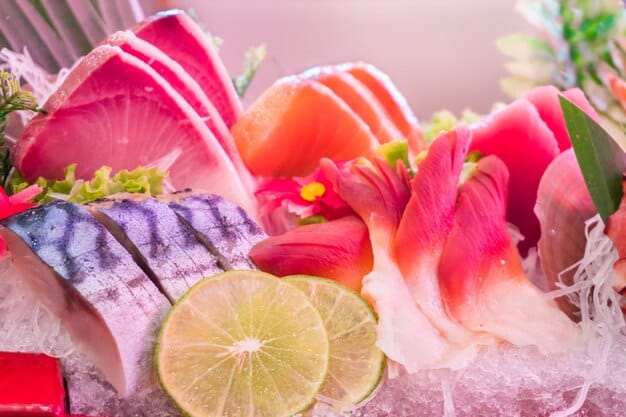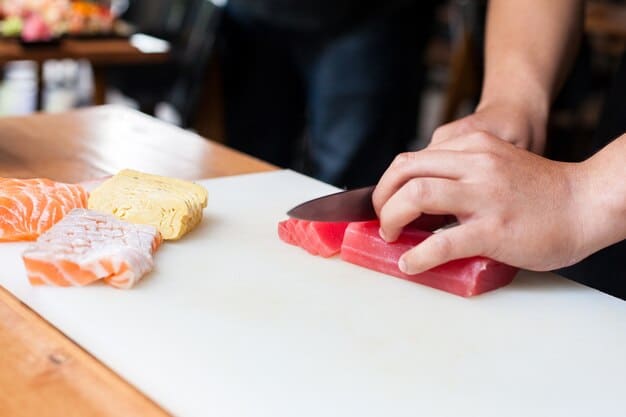Tsukiji Fish Market at Home: Fresh Seafood for US Japanese Cuisine

Bringing the essence of the Tsukiji Fish Market into your US home involves understanding where to source the freshest seafood for authentic Japanese cuisine, from local markets to specialized online vendors.
Craving authentic Japanese cuisine? Discover how to bring the vibrant flavors of **Tsukiji Fish Market at Home: Sourcing the Freshest Seafood for Japanese Cuisine in the US** to your table, no matter where you are in the US.
Bringing Tsukiji Home: An Introduction
The Tsukiji Fish Market in Tokyo, renowned for its vibrant atmosphere and unparalleled seafood quality, has always been a significant landmark for culinary enthusiasts. While traveling to Japan might not always be an option, recreating an authentic Japanese dining experience with the freshest seafood is entirely possible in the US. In this guide, we’ll explore how to bring the essence of Tsukiji to your kitchen.

Understanding Seafood Quality
Knowing what to look for in fresh seafood is crucial to replicating the authentic flavors of dishes enjoyed at Tsukiji. This involves understanding the signs of freshness and the grades of seafood best suited for different culinary applications. For truly authentic Japanese cuisine, quality is paramount.
Signs of Freshness
When sourcing seafood, several key indicators can help you determine its freshness. These signs are essential to ensure you’re selecting the best ingredients:
- Smell: Fresh seafood should have a mild, sea-like aroma. Avoid anything that smells overly fishy or ammonia-like.
- Appearance: Look for vibrant colors and a moist, glossy surface. The flesh should be firm and spring back when touched.
- Eyes: For whole fish, the eyes should be clear, bright, and slightly bulging. Sunken or cloudy eyes indicate that the fish is not fresh.
- Gills: The gills should be bright red or pink and free from slime.
By paying attention to these indicators, you can ensure that you’re choosing the freshest seafood available, which is a cornerstone of delectable Japanese cuisine.
Seafood Grades
Understanding the different grades of seafood is equally important, especially for dishes like sashimi and sushi where the seafood is consumed raw. The term “sushi-grade” or “sashimi-grade” isn’t officially regulated, but generally refers to seafood that has been handled with extra care to minimize the risk of bacteria and parasites.
- Sushi-Grade: Typically flash-frozen to kill parasites, it is essential for raw dishes.
- A Grade: High-quality, suitable for various cooking methods, but exercise caution for raw consumption.
- Commercial Grade: Best used for cooked dishes and preparations where seafood is thoroughly heated.
Selecting the appropriate grade ensures both the quality and safety of your culinary creations, allowing you to enjoy the authentic taste of Japanese seafood at home.
Mastering the art of selecting high-quality seafood can elevate your home cooking, bringing the authentic tastes of Tsukiji to your dining table. By focusing on freshness and grade, you’re one step closer to crafting delightful Japanese dishes that impress.
Sourcing Seafood Locally in the US
The most accessible route to fresh seafood might be right in your neighborhood. Many local markets across the US offer a selection of high-quality seafood, and support local businesses. Here’s how to navigate these options effectively:
Local Fish Markets
Visiting local fish markets can offer a unique experience and the chance to find some truly fresh catches. These markets often source directly from local fishermen, delivering a broad array of options. Interacting with vendors will enrich your knowledge and guide your selection.
- Direct from Fishermen: Supports local economy and ensures freshness.
- Variety: Offers a diverse selection, including regional specialties.
- Expert Advice: Vendors can provide guidance on preparation and best uses.
Asian Supermarkets
Asian supermarkets are another excellent resource, particularly if you are looking for types of seafood commonly used in Japanese cooking. These stores often carry a variety of fresh, frozen, and dried seafood products, catering specifically to Asian cuisines.
- Specialty Items: Find ingredients like uni (sea urchin), ikura (salmon roe), and other Japanese culinary staples.
- Competitive Prices: Often more affordable than specialty fish markets.
- Authenticity: Tailored selections to match Japanese culinary needs.
Building Relationships
Consider developing relationships with your local fishmongers. This can provide you with insider knowledge about when the freshest catches arrive and even allow you to place special orders for specific types of seafood. Building relationships can be very advantageous.
Sourcing seafood locally not only supports regional businesses but also offers the chance to find unique and high-quality ingredients that can transform your homemade Japanese dishes.

Online Seafood Vendors
For those who may not have access to quality local markets, online seafood vendors offer a convenient alternative. These services ship fresh seafood directly to your door, providing access to a wide range of products from around the world. Here are some considerations to keep in mind when choosing an online vendor:
Reputable Online Retailers
Choosing the right online retailer is essential for ensuring the quality and freshness of your seafood. Look for vendors with a strong reputation and transparent sourcing practices.
- Read Customer Reviews: Assess the experiences of other customers regarding quality and service.
- Check Sourcing Information: Understand where the seafood comes from and how it is handled.
- Verify Shipping Methods: Ensure the vendor uses appropriate methods to keep the seafood fresh during transit.
Sustainability Certifications
Sustainability is an important consideration when purchasing seafood online. Look for vendors who offer sustainably sourced products, certified by organizations like the Marine Stewardship Council (MSC) or the Aquaculture Stewardship Council (ASC).
- Eco-Friendly Practices: Supports responsible fishing and aquaculture.
- Transparency: Provides assurance that the seafood is harvested with minimal environmental impact.
- Ethical Consumption: Aligns with responsible consumer choices.
Purchasing from sustainable sources guarantees both the health of our oceans and maintains high standards. Online seafood vendors provide valuable access for anyone keen on enjoying authentic cuisine.
Preparing Seafood at Home
Once you’ve sourced your fresh seafood, proper preparation is key to creating authentic Japanese dishes. Here are some essential techniques and tips to ensure your seafood is both safe and delicious:
Essential Techniques
Mastering a few key techniques will elevate your seafood preparation. Proper handling and precise cutting are essential for sushi and sashimi.
- Proper Storage: Keep seafood refrigerated and use it as soon as possible.
- Correct Cutting: Use a sharp knife to create clean, even slices
- Cleanliness: Always use clean utensils and cutting boards to prevent contamination.
Recipe Ideas
From the minimalist elegance of sashimi to creative takes on sushi rolls, the possibilities are endless with fresh seafood. Here are a couple ideas to get you started:
- Sashimi Platter: Arrange a selection of sliced tuna, salmon, and yellowtail on a platter with wasabi and soy sauce.
- Spicy Tuna Rolls: Combine minced tuna, spicy mayo, and avocado in sushi rolls.
These ideas offer great ways of demonstrating your culinary skill and are exciting starts.
Safety and Handling Tips
Beyond freshness, food safety is paramount when preparing seafood at home. Understanding how to properly handle and store seafood can prevent foodborne illnesses and preserve its quality. Following these steps ensures your meals are not only enjoyable but safe.
- Temperature Control: Keep seafood refrigerated at 40°F (4°C) or below.
- Prevent Cross-Contamination: Use separate cutting boards and utensils for seafood.
- Cook Thoroughly: Cook seafood to an internal temperature of 145°F (63°C).
Here are a few points to keep in mind:
- Use by Date:Always check the “use by” or “sell by” date.
- Proper Thawing: Thaw seafood in the refrigerator, not at room temperature.
Always prioritize safety when preparing seafood at home to savor authentic Japanese flavors worry-free.
| Key Point | Brief Description |
|---|---|
| 🐠 Seafood Freshness | Learn to identify fresh seafood by smell, appearance, eyes, and gills. |
| 🍣 Seafood Grades | Understand sushi-grade seafood for safe raw consumption. |
| 🛒 Local Sourcing | Visit local fish markets and Asian supermarkets for diverse seafood options. |
| 🌐 Online Vendors | Choose reputable online retailers with sustainable seafood certifications. |
Frequently Asked Questions
▼
Check for a mild sea-like smell, vibrant colors, firm flesh, clear and bright eyes (if whole), and bright red or pink gills. Avoid fish with an overly fishy or ammonia-like odor.
▼
“Sushi-grade” generally refers to seafood that has been handled carefully and often flash-frozen to kill parasites, making it safe for raw consumption. However, there’s no official regulation.
▼
You can find fresh seafood at local fish markets, Asian supermarkets, and reputable online vendors. Local markets provide regional specialties, while Asian supermarkets often carry Japanese culinary staples.
▼
Store seafood in the refrigerator at 40°F (4°C) or below, and use it as soon as possible. If you need to freeze it, wrap it tightly in plastic wrap and then aluminum foil.
▼
Yes, but choose reputable online retailers that employ proper shipping methods and offer sustainably sourced products. Check customer reviews and verify sourcing information before making a purchase.
Conclusion
Bringing the **Tsukiji Fish Market at Home: Sourcing the Freshest Seafood for Japanese Cuisine in the US** to your own kitchen is an achievable and fulfilling culinary adventure. By understanding the essence of sourcing and preparing fresh, high-quality seafood, you can create authentic and delightful Japanese dining experiences right in your home.





